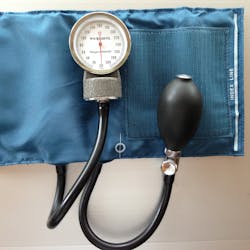Robust evidence from a large international study confirms that a difference in blood pressure readings between arms is linked to greater risk of heart attack, stroke and death, according to a press release.
Led by the University of Exeter, the global INTERPRESS-IPD Collaboration conducted a meta-analysis of all the available research and then merged data from 24 global studies to create a database of nearly 54,000 people. The data spanned adults from Europe, the United States, Africa and Asia for whom blood pressure readings for both arms were available.
Funded by the National Institute for Health Research (NIHR) and published in Hypertension, the study is the first to conclude that the greater the inter-arm blood pressure difference, the greater the patient's additional health risk.
Currently, international blood pressure guidelines advise health professionals to measure blood pressure in both arms when assessing cardiovascular risk – yet this is widely ignored, NIHR said. The new study provides a new upper limit of 'normal' for an inter-arm difference in blood pressure, which is significantly lower than the current guidance.
The research could lead to a change in international hypertension guidelines, meaning more at-risk patients could be identified and receive potentially life-saving treatment.
The team analyzed data on inter-arm blood pressure difference, and tracked the number of deaths, heart attacks and strokes that occurred in the cohort over 10 years.
Blood pressure rises and falls in a cycle with each pulse. It is measured in units of millimetres of mercury (mmHg), and the reading is always given as two numbers: the upper (systolic) reading, which represents the maximum blood pressure, and the lower (diastolic) value, which is the minimum blood pressure. A high systolic blood pressure indicates hypertension.
This affects one third of the adult population and is the single leading cause globally of preventable heart attacks, strokes and deaths. A significant difference between the systolic blood pressure measurements in the two arms could be indicative of a narrowing, or a stiffening, of the arteries, which can affect blood flow. These arterial changes are recognized as a further risk marker for subsequent heart attack, stroke or early death, and should be investigated for treatment.
The researchers concluded that each mmHg difference found between the two arms, elevated predicted 10-year risk of one of the following occurring by one percent; new angina, a heart attack or stroke.
An inter-arm difference of greater than 10 mmHg occurs in 11 per cent of people with high blood pressure (hypertension) – itself a known health risk – and in four percent of the general population.

